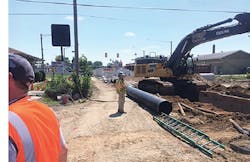Evaluation and planning are key to mitigating risks associated with infrastructure needs.
By Alanna Maya
2/1/18
Many communities across the country are struggling with the ability to maintain their water infrastructure. AWWA’s 2017 State of the Water Industry Report suggests that renewing the country’s aging water and wastewater infrastructure is the number one concern of water utility workers in North America; and the American Society of Civil Engineers’ 2017 Infrastructure Report Card grades the United States water and wastewater systems a D and D+, respectively. Additionally, analysis from ASCE projects the U.S. water and wastewater system infrastructure investment gap at $82 billion per year.
American Water, the nation’s largest investor-owned water and wastewater services company, currently services approximately 50,000 miles of mains and collection pipes, in addition to 81 surface water plants and over 100 wastewater plants, and some 81 dams — treating and delivering about one billion gallons of water every day to its customers. Ongoing evaluation and planning are key components of American Water’s approach to combating infrastructure needs.
“We like to say that we are like a microcosm of the water industry because most of our water systems are small, yet most of our customers are served by our lager systems,” James J. Chelius, P.E., engineering director of corporate planning for American Water, said. “If there is a water industry problem, we have had it, [and] infrastructure is certainly one of those challenges.”
Tennessee American Water employees work on installing a valve in preparation for laying new pipe at the Citico water plant in Chattanooga, Tenn.
Sound Planning
American Water has tackled the problem of aging infrastructure in a few ways, but all involve focused planning for the future to avoid service interruptions or public health emergencies. Comprehensive studies of service areas and treatment plants through its master planning program look at an entire water or wastewater system, from the intake all the way to the customer tap. This helps American Water engineers to determine system needs and plan improvements to coincide with growth, new water quality regulations, reliability, operational efficiency, and of course, aging infrastructure.
“In each of our states, our pipeline renewal program, [allows us] to look at routine pipeline renewal based on sound asset management practices, condition, performance versus risk or likelihood of failure and some key criteria like main breaks, water quality issues, and critical customer dependency,” Chelius said.
Another area where American Water focuses planning efforts is in new technology. For example, Chelius pointed to pipeline rehabilitation as a cost-effective alternative to total pipe replacement. “Particularly in highly urbanized areas [where] rehab can be up to 50 percent of the cost to replace, we try to take advantage [of these tools,] including slip lining, cement mortar lining, or rehabbing the structural integrity of the pipe.”
Acoustic monitoring and pressure management, Chelius said, have also helped identify pipe leaks before they become breaks, reducing interruption to distribution lines in the process.
“Through pressure management, we are asking the question, ‘Can we make our pipes last longer?’ or, in other words, relieve some of the stress on the pipe by reducing the pressure in certain areas,” he said.
But all the planning in the world doesn’t change the fact that infrastructure repairs can be costly, and the issues are not going away any time soon. Smart agencies, said Chelius, will plan to spend on much needed upgrades.
“We have a lot of pipeline, and we invest so that we can continue to provide essential services to our customers. We spend more than a billion dollars a year on our capital program, which targets everything from pipelines to treatment plant upgrades to pump stations, tanks and so on,” Chelius said. “I would emphasize that investments need to be targeted, and we need to make sure that we are providing the most cost-effective, sustainable solution to mitigate the highest risks.”
VIDEO: Advocating for water and wastewater infrastructure
At the NEWEA 2018 Annual Conference, water and wastewater utility experts weigh in on the importance -- and benefits -- of engaging with legislators.
Funding Repairs
American Water’s Distribution System Infrastructure Surcharge, a fee representing a small percentage on a customer’s bill that grows in the period between rate cases as investments are being made, has allowed the utility to recover the costs associated with repairs more quickly since being implemented in some areas. Chelius said the money raised from the surcharge has incentivized the utility to invest more.
“We sometimes have to make tough decisions on where our money goes because it is not an unlimited source,” he said. “It helps to have a mechanism that helps us to get a little bit more bang for the buck in making those infrastructure renewal dollars go a bit further.”
Looking ahead, EPA’s Water Infrastructure Finance and Innovation Act (WIFIA) loans could help utilities finance much needed repairs and upgrades to aging systems. Established by the Water Infrastructure Finance and Innovation Act of 2014, the federal credit program administered by EPA for eligible water and wastewater infrastructure projects will provide low interest loans to organizations that support water and wastewater infrastructure projects.
Twelve projects were recently selected to apply to the program, seeking over $2 billion to help finance a total of over $5 billion in water infrastructure investments, according to the EPA. The majority of agency applications sought funding for specific large-scale projects, like the Metropolitan St. Louis Sewer District (Mo.), which asked for $43 million to construct a new pump station, replace approximately 15,900 feet of sanitary sewer, and slip line 1,700 feet of sanitary sewer; and the Orange County Water District (Calif.), which asked for $124 million to expand its existing water recycling plant from 100 million gallons per day (mgd) to 130 mgd.
The Indiana Finance Authority (IFA), however, took a different approach. Seeking $436 million in funding, IFA plans to act as an intermediary between water and wastewater utilities in the state, distributing WIFIA funding for projects based on a statewide priority list.
“WIFIA’s mission is to quickly and efficiently deploy funds for infrastructure projects nationwide, [so this is] going to be a much quicker deployment of those funds because it is going to be essentially negotiating one loan agreement with us, and we are going to spread the funds to 5 or 10 borrowers, versus EPA having to negotiate an individual loan agreement with [a number of] borrowers,” Jim McGoff, Indiana Finance Authority’s director of environmental programs, said.
IFA currently oversees the State Revolving Fund (SRF) loan programs for the State of Indiana. With standard lending practices already in place, McGoff said IFA would act as a conduit between the WIFIA program and individual utilities.
The Indiana Finance Authority (IFA) has helped finance infrastructure repairs throughout the state, like this Installation of water main in Goshen, Ind. As an applicant for EPAs WIFIA funding, IFA hopes to expand on its lending capabilities. Photo courtesy IFA.
From IFA’s Letter of Interest and WIFIA program application: “By use of its dynamic programmatic processes (rather than being tied to one given specific infrastructure project or a limited group of such projects), any WIFIA funding (if made available) will be integrated in a way that is consistent with and supportive of what IFA currently does (and has historically developed) along with SRF funding to help meet the needs demonstrated by its Project Priority Lists for SFY 2017.”
As projects on IFA’s priority list are completed, McGoff said IFA will help fund other projects with a mix of WIFIA and state funding. While IFA has not determined just exactly how the money would be divided among the varied projects in the state, McGoff said one option currently on the table would be to limit the WIFIA funds to the largest 5 or 10 projects, leaving smaller projects to be paid for with other state programs.
“We have not determined how we are going to deploy the funding but we know that we can make quick use of it over the next 2-3 years,” he said.
The most recent statewide study and analysis of drinking water infrastructure needs conducted by IFA, Evaluation of Indiana’s Water Utilities, 2016, showed the cost to repair or replace aging infrastructure to be at $2.3 billion. The report noted that there was “no obvious lead agency for statewide water management,” and “a comprehensive water plan is needed that includes both supply and demand needs.”
In response to the report, IFA set aside a portion of its SRF funding to be applied to a lead testing program to help public schools evaluate their systems and take care of protecting the children that they serve, McGoff said. A total of $3.5 million has been set aside for the program, which takes water samples in each of Indiana’s public school buildings to determine the level of lead in the water supply. “As we learned about issues in Flint (Mich.) and we learned about the potential impacts that lead service lines could have on a population, we decided [to implement this program]. We understood through our research that many of the schools — perhaps up to 75 percent — would have positive [lead] tests but the fix that would be required was very simple,” Mc Goff said.
In most cases, simply switching out a faucet or posting a sign above any sinks not suitable for drinking water purposes was all that was required of the school building after results were received. Today, IFA is about halfway through the testing process in all of the state’s public schools, and McGoff said while the project is “quite a large undertaking, the actual investment is nominal compared to the results.”
A resource for communities looking for new ways to finance water infrastructure projects, the “Living Map” created by Stanford researcher Newsha Ajami and her team features case studies of successful innovative water financing efforts around the country. Photo courtesy Stanford Water in the West.
Thinking Out of the Box
For communities looking for ways to finance critical infrastructure repairs, a “living map” created by researchers at Stanford University could save time.
“We need a new playbook that embraces a holistic view of our water system and offers new ideas and solutions for our aging infrastructure,” Newsha Ajami, director of urban water policy at Stanford’s Water in the West program and leader of the map project, said in a statement from the university. “Integrating distributed water projects such as green infrastructure, wastewater recycling and storm- and graywater reuse into our current infrastructure network can enhance the flexibility and reliability of our water systems.”
The Living Map, available online, is populated with case studies of successful water financing efforts. Large- and small-scale projects from communities across the country are represented, and feature multiple funding mechanisms. Based on a previous report from Stanford that created a framework for funding in the electricity sector, the map will be updated with new case studies over time and as infrastructure needs grow. “The fact that it’s hard to access funding for distributed and unconventional water projects is not an excuse not to act,” Ajami said in a statement.
The Living Map is a live look at what is happening in the water sector, and shows how innovative communities have become in finding the funds to complete their water projects. Indeed, the map shows there is not a “one size fits all” approach to solving the water infrastructure needs in the U.S. WW
About the Author: Alanna Maya is the assistant editor for WaterWorld Magazine. Email her at [email protected].









